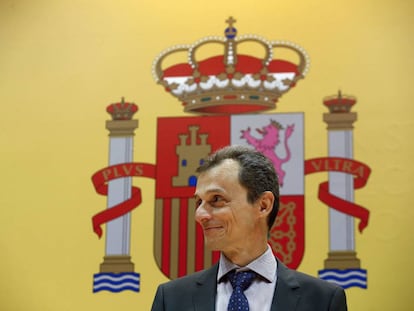The Spaniards who helped with the Moon landing
Fifty years ago, a handful of technicians from the country were recruited by NASA to assist the US astronauts on their historic mission. This is what they said about the experience


It’s midday on Monday and a group of 21 senior citizens (20 men and one woman) are struggling up a ramp towards an enormous satellite dish that points at the sky. When they get to the top, they pose for a photo, many of them yelling “cervezaaaa,” the Spanish equivalent of “cheeeeese,” as though they were teenagers.
These are the Spaniards who were there for the Moon landing: engineers, technicians, cooks, waiters, and documentary makers who witnessed history being made at an unlikely moment for Spain, which was still under the dictatorship of Francisco Franco.
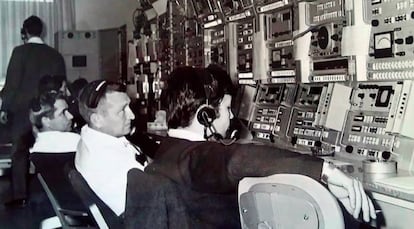
They worked at NASA’s space monitoring stations in Robledo de Chavela and Fresnedillas de la Oliva, two villages strategically located in the middle of a mountain, but close enough to Madrid and the Madrid-Barajas airport.
These stations, together with the satellite dishes in Cebreros (Ávila) and Maspalomas in the Canary Islands, and two more in Australia and the United States, were the connecting links between the Earth and the astronauts who landed on the Moon for the first time, 50 years ago.
The only woman in the group was María Nieves de la Peña. She was 17 years old when she began working as a waitress at the base. On the night of July 20, 1969, she didn’t have anything to do. “I was working but nobody was coming for coffee. When I finished my shift, I snuck into the room where they were following the mission. It was amazing,” she remembers.
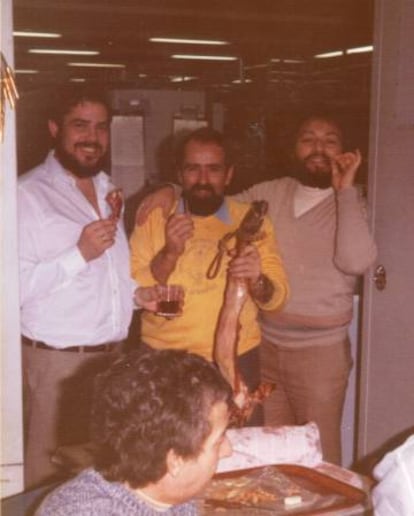
Sitting in front of one of the communication consoles was 22-year-old Carlos González, the son of farmers who had moved from the northern region of Asturias to Madrid. At that moment, Madrid was the only station that had direct contact with the astronauts. “All my attention was on the equipment that received the signal from [Michael] Collin’s orbital module and the Eagle of [Neil] Armstrong and [Edwin] Aldrin, who were meant to land on the Moon. I prayed silently for communications not to fail, because if they did, the mission would be stopped,” remembers González, who is now 73 years old. This engineer had the privilege of being one of the first people on Earth to hear the historic words: “Houston, Tranquility Base here. The Eagle has landed.”
It was 9.17pm in Madrid and humankind had just set foot on the Moon. The words of Apollo 11 Commander Neil Armstrong arrived first at Fresnedillas. Half a second later they were relayed to other monitoring stations. González knew the mission had succeeded even before US President Richard Nixon did. “I felt a rush of electricity run through my body and I thought, we have done it. But beyond that, you still have the responsibility of doing your job well,” he explains.
A few hours later, the Moon dropped behind the horizon and the Honeysuckle Creek satellite dish in Australia took over. The team at Fresnedillas toasted the success with a glass of wine, the first of many celebrations with ham, shrimp and seafood paella that would be held to mark future achievements, as José Manuel Grandela describes in his book Fresnedillas y los Hombres de la Luna (or Fresnedillas and the Men of the Moon).
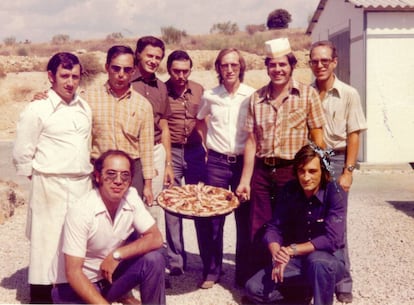
Grandela had been working just a few months at the NASA base when Apollo 11 landed on the Moon. “That night there was a moment when we thought they weren’t going to land,” he remembers. The Eagle’s autopilot was guiding the two astronauts to a rocky area which was dangerous for such a fragile spacecraft. Armstrong took hold of the ship’s manual controls and was able to guide it to a flat area, six kilometers from the original spot. “We saw that their pulse rate was very high. Charlie Duke, who was the only person authorized to directly address the astronauts from the Houston mission control center, said: ‘“Roger, Tranquility. We copy you. You got a bunch of guys down here about to turn blue,’” recounts Grandela, who worked as a radio operator at the station for decades.
Armstrong set foot on the Moon on July 21 at 3.56am, local time in Madrid. Ten million Spaniards were following the landing on television. The team at Fresnedillas took over again a few hours later when the astronauts started up the Eagle’s engine to return to the orbital module and prepare to return to Earth.
The NASA station outside of Madrid was like a small town unto itself. The base had its own cars to drop off each worker at their home. There were volleyball and soccer teams. Some even found their life partners like María Nieves, who married the engineer David Villena (who is posing to her right in the photo).
“When Apollo 11 [landed], everyone was an American except for me inside the special Apollo operations building,” remembers González. But this situation gradually change with each new mission.
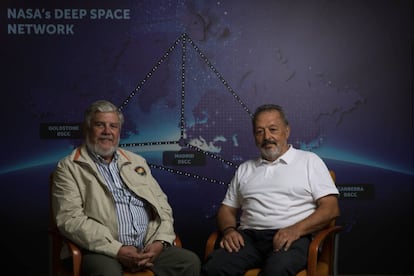
“They increasingly let more Spaniards go inside, and when one Apollo arrived, I don’t remember which one, there were only Spaniards on some teams,” says José Antonio Perea, an 84-year-old former radio operator.
“Everything that was received by the station was recorded on magnetic tapes that I stored in tagged cans that were sent as quickly as possible to Barajas airport, where an airplane was waiting to take them to the United States. Only copies remain here,” explains 78-year-old documentary maker José Castán, who came to the base when he was 26 years old in the middle of the 1968 Apollo 8 mission, which was the first to orbit the moon.
Missing from Monday’s photo is Luis Ruiz de Gopegui, a physicist from Madrid who got to be director of Fresnedillas, and who at 91 years of age was unable to make the trip to Robledo. But he speaks lucidly on the phone about his experience that day. “Back then I was just another foot soldier. I was 41 years old and in charge of the satellite system. I don’t have many special memories. We did not realize the importance of what we were doing. Nobody thought that we wouldn’t return to the Moon over the next 50 years,” he explains.
Four years after the success of the Moon landing, Armstrong, Aldrin and Collins came to visit Spain. The Franco regime prepared a full agenda in Madrid: meeting Franco in El Pardo, a victory parade in the central Gran Vía thoroughfare in a convertible car, a press conference. While there was time to give the astronauts a matador costume and ask them to put on a montera [matador hat] in front of the cameras, which they did reluctantly, there was not time to visit either the Robledo or Fresnedillas stations and meet the Spaniards who had helped ensure the success of their mission. Gopegui was able to attend one of the events held for the astronauts. “I was able to greet Armstrong, but not to meet him. They were treated like gods. He shook my hand but he didn’t know who I was.”
English version by Melissa Kitson.
Tu suscripción se está usando en otro dispositivo
¿Quieres añadir otro usuario a tu suscripción?
Si continúas leyendo en este dispositivo, no se podrá leer en el otro.
FlechaTu suscripción se está usando en otro dispositivo y solo puedes acceder a EL PAÍS desde un dispositivo a la vez.
Si quieres compartir tu cuenta, cambia tu suscripción a la modalidad Premium, así podrás añadir otro usuario. Cada uno accederá con su propia cuenta de email, lo que os permitirá personalizar vuestra experiencia en EL PAÍS.
¿Tienes una suscripción de empresa? Accede aquí para contratar más cuentas.
En el caso de no saber quién está usando tu cuenta, te recomendamos cambiar tu contraseña aquí.
Si decides continuar compartiendo tu cuenta, este mensaje se mostrará en tu dispositivo y en el de la otra persona que está usando tu cuenta de forma indefinida, afectando a tu experiencia de lectura. Puedes consultar aquí los términos y condiciones de la suscripción digital.
More information
Archived In
Últimas noticias
Venezuela hardens its ‘revolutionary state’ project amid pressure from Trump
Sydney Sweeney, the actress praised by Trump: ‘Women are up against what society wants them to be’
The Bolsonaro surname: An advantage or liability in Brazil’s 2026 presidential elections?
Raúl Rocha, from jet-setting with Miss Universe to arms trafficking and fuel theft
Most viewed
- Reinhard Genzel, Nobel laureate in physics: ‘One-minute videos will never give you the truth’
- Pablo Escobar’s hippos: A serious environmental problem, 40 years on
- Charles Dubouloz, mountaineering star, retires at 36 with a farewell tour inspired by Walter Bonatti
- Why we lost the habit of sleeping in two segments and how that changed our sense of time
- The fall of a prolific science journal exposes the billion-dollar profits of scientific publishing

